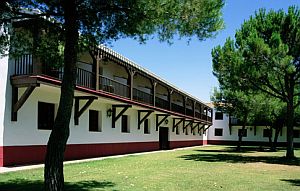Albacete, La Manche, SpainCapital of the province by the same name, Albacete is located in the southeast region of La Manche. The original settlement was occupied by the Moors until the Christians recaptured it in 1241. It changed very little over the next two centuries until it was eventually declared a borough and granted permission to hold a market once a week. But there after it doubled in population and really and really began to flourish. Today it is quite a modern city and where it lacks in ancient architecture it makes up for in a layout that is beautifully landscaped with green parks and pedestrian areas making it very convenient and pleasant to get about. Because it grew in such prominence and wealth it was soon included on the railway route from Madrid to Alicante, which means nowadays visitors can enjoy the benefit of excellent train services to the country’s capital and the Mediterranean. The Aviation industry has always been very important to the city and it is here that a training centre for NATO pilots is based. Albacete is also known for the production of fine daggers and knives, and if you are particularly interested in such things there is a small museum located in the Casa del Hortelano. Being a University town as well it has a young and vibrant energy with several festivities held throughout the year. One of the highlights is the Feria de Albacete in September. The festival lasts for ten days and attracts tourists from all over the world. Also in September is the International Circus Festival so this is a particularly entertaining month to visit. The three main centres to the city are the Cathedral Square, the Plaza Mayor, and the Plaza Carretas. Its two greatest attractions are the Cathedral and the Albacete Museum. The Cathedral of San Juan Bautista is located in the oldest part of the city and although it dates back to the Gothic period it is made up of many different styles of architecture. It started out as a small church in the 16th century but was later expanded into the Cathedral you see today which took four hundred years to complete. Two of its most celebrated features are the chapel of the Virgin of the Plains with its vaulted ceilings and star shaped skylights, and its Renaissance altarpieces. The Albacete Museum is located in the city’s central park which is very much the heart of the community. It tells the history and heritage of Albacete through exceptional exhibits of archaeological and ethnological findings. It also has an excellent fine art exhibit which includes many contemporary works. Being a fairly modern city there are only pockets of more historical architecture and one such place is the Passage Lodares which reflects the prosperity back in the early 1900’s. Lined with elegant homes decorated with attractive balconies you will see many Renaissance or Modernist elements to their design.  Should you wish to get out of the city for a while you are only 4km away from the delightful village of Chinchilla del Monte. Or not that far away is the Lagunas de Ruidera Nature Reserve. There are also excursions at certain times of the year into the Alcacaz mountains. As for outdoor activities kayaking, horseback riding and golf are just a few of the many options available.
Should you wish to get out of the city for a while you are only 4km away from the delightful village of Chinchilla del Monte. Or not that far away is the Lagunas de Ruidera Nature Reserve. There are also excursions at certain times of the year into the Alcacaz mountains. As for outdoor activities kayaking, horseback riding and golf are just a few of the many options available.
Albacete offers an excellent choice of accommodation, but one hotel in particular is the Parador Hotel Albacete just on the outskirts of town. Formerly a country Manor House, it is now a luxury four star hotel with its own restaurant, seasonal swimming pool, garden and tennis court. |